Steemian Friends,
Today, I will write a Steemit Learning Challenge 22 Week 03 Industrial Electrical Lesson. This week, I will discuss making lightning arresters and electric generators for students. Due to climate change, lightning has increased in different countries. Every year, many people are killed by lightning. So, this week, we will learn how to make a lightning arrester. So, let's start the lesson.
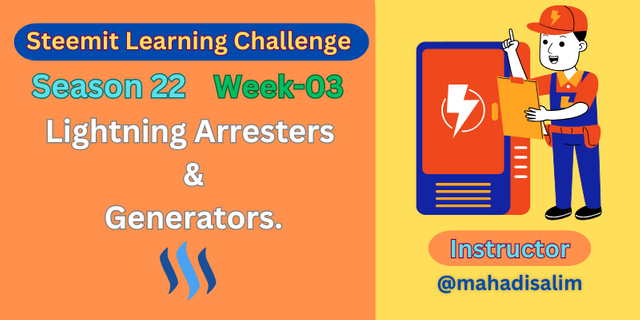
Design By Canva
Lightning Arrester is a system that prevents the lightning caused by the friction of clouds in the sky from causing damage to the earth. When thunder strikes the sky, it falls on tall buildings, trees, and people on earth. Electricity is supplied through high lines with electricity poles. So, most lightning strikes on power lines. When lightning strikes a power line, a type of excess voltage is produced called surge voltage. This excess surge voltage is protected from accidents by being sent through the wire using earthing.
Power companies transmit the surge voltage generated by lightning to the ground in various ways. I have discussed a few ways below.
A horn gap lightning arrester is used in LT electricity loads. Power companies use horn gap lightning arresters to protect transformers. A horn gap lightning arrester is made of two narrow pieces of copper on the bushing of the transformer. The transformer is fitted with insulators to its body. A fixed gap is kept between the two copper pieces. Transformers are placed outdoors. In case of sudden lightning, the surge voltage generated by the horn gap lightning arrester is sent to the ground through the body earthing of the transformer to protect it from damage. At this time, the copper piece of the horn gap sparks between the two gaps. This is how the horn gap lightning arrester works. Power companies use horn gap lightning arresters.
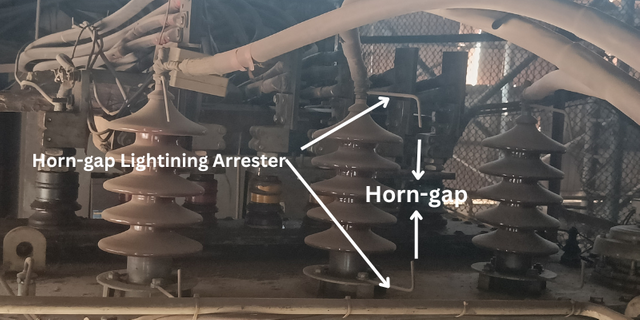
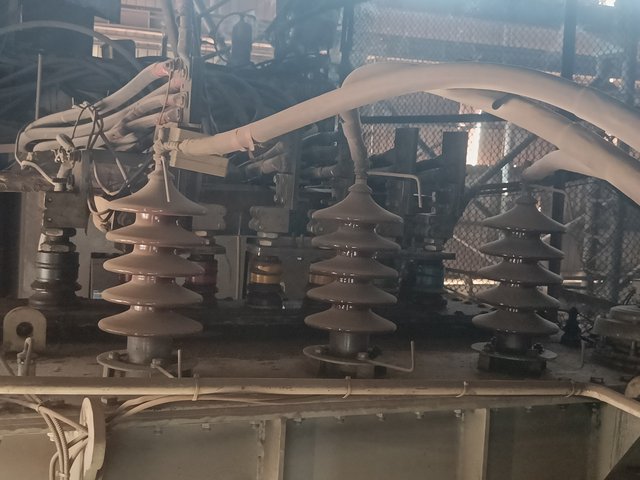
Horn gap lightning arresters used with bushings of transformers
Electricity companies use lightning arresters in two systems for the HT side. Below, I have discussed two methods.
- Power company transmission lines are on top of poles. Due to the high voltage, the transmission line is higher, and lightning strikes the line the most. When lightning strikes the high voltage line, the surge voltage increases, and there is a possibility of blowing the electrical appliances in our house. So, the power companies put a copper wire on top of the transmission line. A transmission line consists of a copper wire strung over the phase wire. We often don't know the reason for putting this thin wire. This thin copper wire protects the transmission line in case of lightning. When lightning strikes a transmission line, copper wire earthing transfers the surge voltage to the ground. This copper acts as its lightning arrester. Hopefully, we all know why copper wire is used over transmission lines.
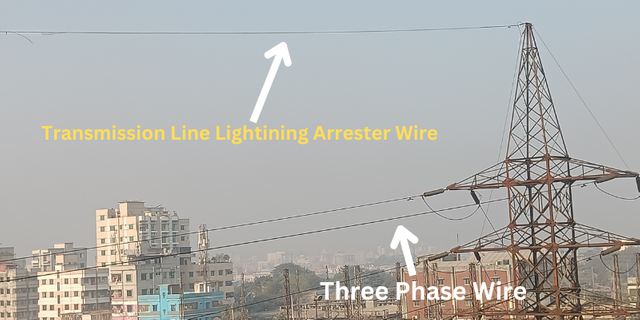
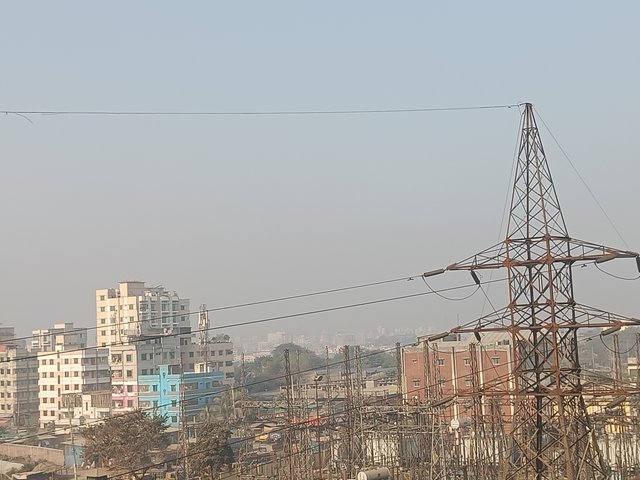
Earthing wire used in transmission lines that acts as a lightning arrester
A type of lightning arrester is used for various kinds of HT equipment, such as VCB in substations. In sudden lightning, this lightning arrester protects the substation's equipment from damage caused by surge voltage. Lightning arresters are installed three in three phases in VCB. Lightning arresters are fitted with insulators to prevent phase currents from entering them. In case of lightning, the surge voltage is sent deep into the ground through the body earthing of the VCB to protect the electrical substation equipment from damage.
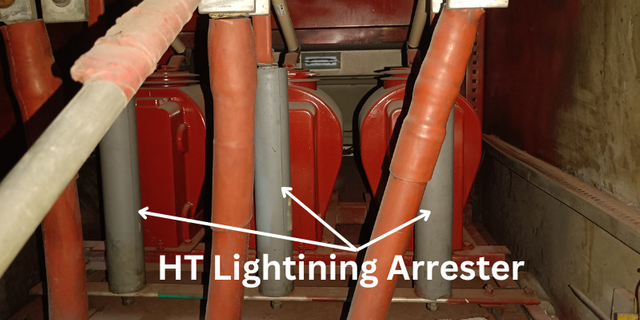
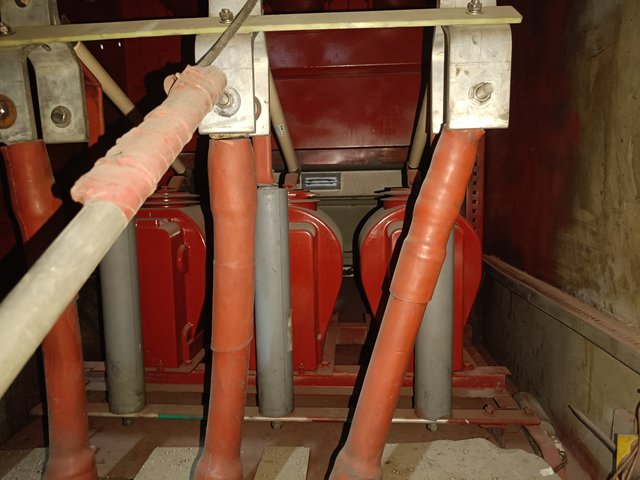
Lightning arresters used in VCBs of electrical substations
We will discuss one of the most important lightning arresters. Due to climate change, the number of lightning strikes is increasing daily. I see many people die from lightning every year during summer in my country. As the climate changes, the number of lightning strikes may increase. Especially due to the cutting of large trees, the damage caused by lightning is rising. So we should install lightning arresters in our homes and offices.
Home-made lightning arresters are easy to make and cost less. The following materials are required to make a lightning arrester at home.
- A piece of copper (3-5) feet long, 16 mm round
- An insulator
- An earthing
- Required cables
- One Earthing
I first cut a 16 mm round three meters of copper. You can take a copper piece of 2/3 meter size. (8-16)mm dia of copper piece can be taken.
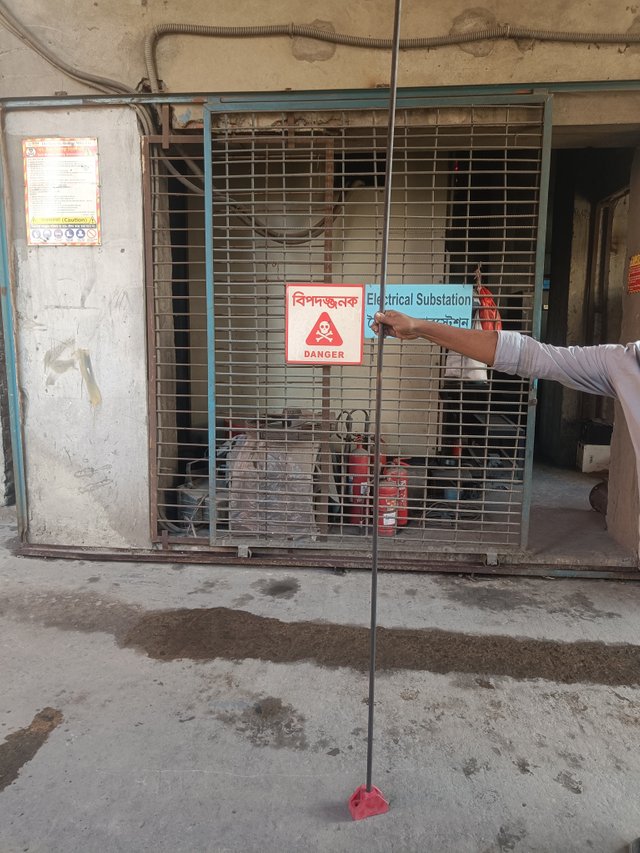
A piece of copper
Then, I have two ceramic insulators. Two insulators separate the copper piece from the other metal. You can use any insulator you want.
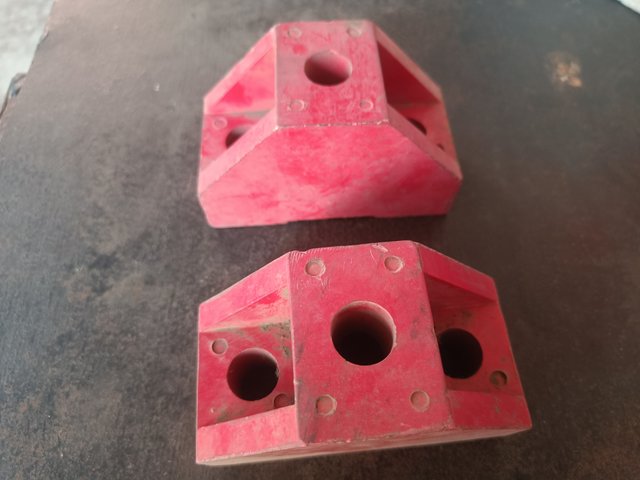
Ceramic insulators
Then, I set the copper piece on the insulator with nuts and bolts so that it is firmly in place. After installing the entire setup on the roof of the house or at a high place, it should be firmly fixed so that it does not fall to the ground.
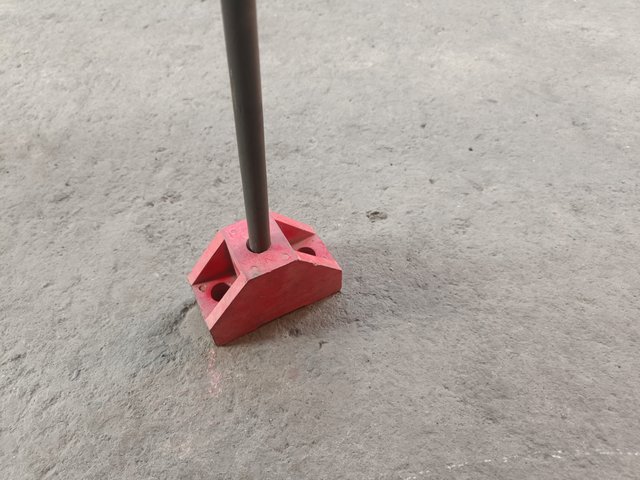
The piece of copper is firmly attached to the insulator
Then, go to the house's roof and place it as high as possible. Lightning usually occurs at high altitudes. Then, connect a (4-10)RM cable to the copper piece. Connect the cable to an earthing. One of the most important things is that the copper piece does not come into contact with other metals. In lightning, the surge voltage will go deep into the ground through the earthing from the copper piece through the cable.
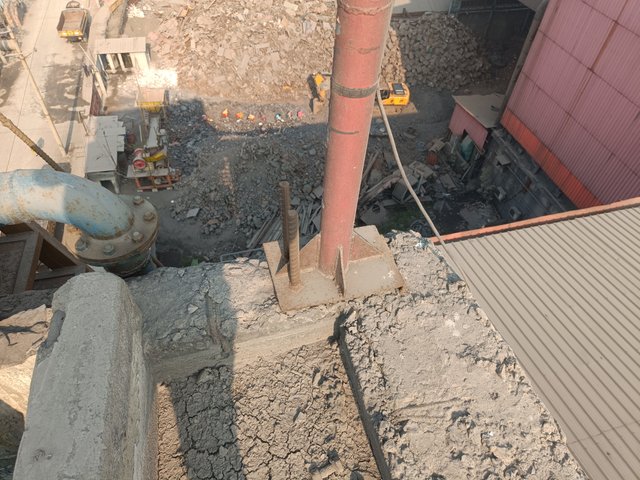
The lightning arrester is firmly installed on the high roof of the house
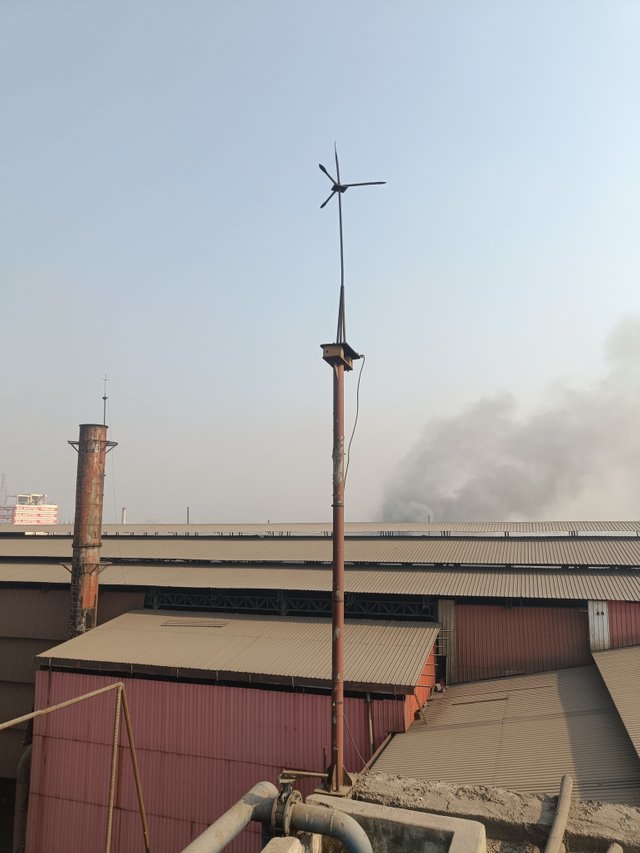
A 6 RM cable is connected to the copper piece
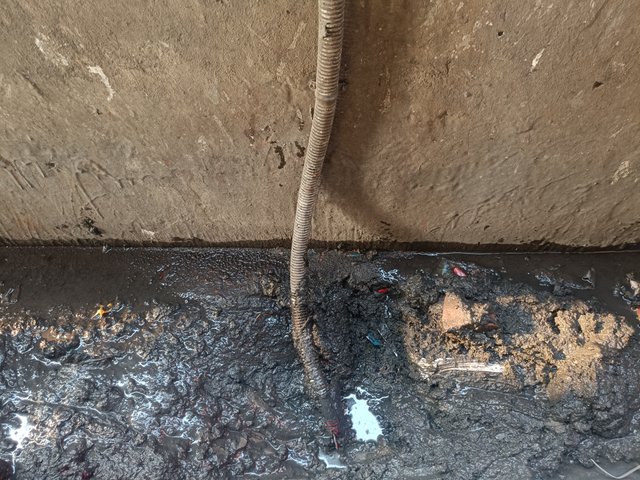
The other end of the cable is connected to an earthing
You can place a piece of copper (2/3 feet) as high as you like from your house. Connect the piece of copper to a cable earthing. I have shown it as an example. You make your own at home. Take care of two aspects: one is to place it high, and the other is that there will be no metal connection other than earthing it with copper.

Selfie with my self-made lightning arrester
I am an electrical engineer in a company. In the last two years, electrical appliances worth about five crores were blown away in a manufacturing unit due to a sudden lightning strike. Then, I built and set up three lightning arresters on top of our company's production unit. The lightning arresters produced very good output. So far, the electrical equipment has not been damaged. You will also benefit from making a lightning arrester in this way.
Generator:
A device that converts mechanical energy into electrical energy is called a generator. A generator is the opposite of an electric motor. The generator consists of two parts. One is the mechanical part of the engine, and the other is the electrical part. The generator has a prime mover. One part consists of a field coil and an armature coil. The flux generated in the field coil cuts through the armature rotation. Armature rotation results in voltage generation based on the flux cut. Generators are of different types.
Types of generators:
Based on electricity, there are two types, namely:
- AC generator
- DC generator
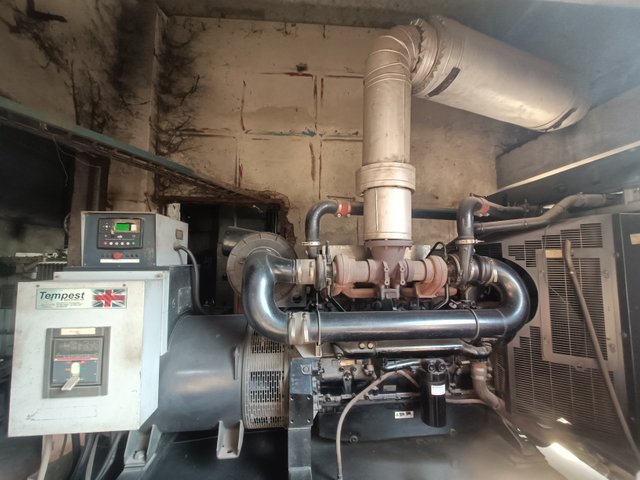
600 KVA Diesel AC Generator
We will learn less about generator theory. I will discuss some important issues that are needed more in reality. We use AC generators the most. Most electrical home appliances in our homes or offices are powered by AC electricity. Power is produced in the prime mover part of the AC generator. We will look at a generator specification. Then, we can learn the basics of the generator.
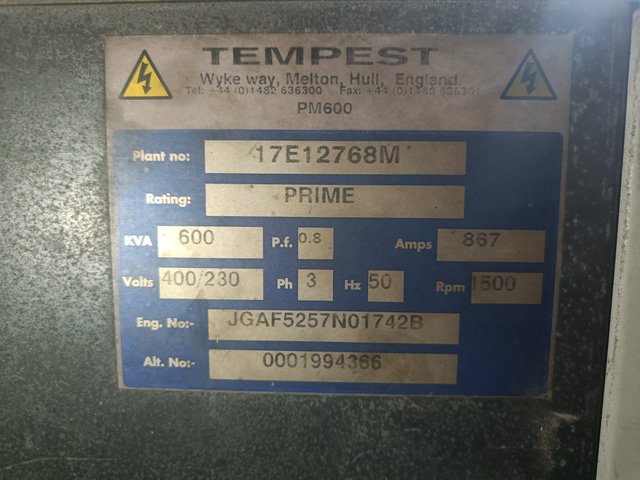
Generator Name-plate
Here, we see a 600 KVA generator. A diesel engine powers this generator. Generators are diesel and gas-powered. Today, I will discuss diesel-powered generators. The output voltage of the generator is 415/220 volts. The power capacity of the generator is 867 amperes. The RPM of the generator is 1500. The power factor of the generator is 0.8. We can use a diesel generator for 80% of the load. So, at 80% load, we get 480KVA as output. Now, I am taking out the kilowatts and amperes of the 480 KVA generator and showing them below. Then, we will know how many electrical home appliances we can run with a 600 KVA generator.
Given,
Power,P = 480 KVA
Power Factor = 0.8
We know,
Power Factor = KW/KVA
or, KW = KVA * Power Factor
= 480 * 0.8
= 384 KW
Voltage, V = 415 volts
We know,
P= √3 V I power factor
or, I = P/ √3 V Power factor
or, I = 480 * 1000/1.73 * 415 * 0.8
or, I = 835 A
Ans: 0.8 power factor 600 KVA generator load current will be 835 amperes.
In previous lessons, we learned to calculate the electrical load of our house, so we won't be learning how to calculate electrical loads this week. You may need to purchase a generator for your home or provide generators on a customer-load basis. Then, you should buy a generator with a rating of at least 20% higher than the KVA you get based on the load. Frictional losses occur in the generator engine.
A. Write three basic differences between the electrical generator, motor, and transformer.
B. Give details about lightning arresters used in the electricity sector in your country.
C. What is the actual current of a three-phase 1500 KVA, 0.9 power factor generator?
- If the generator is given an 80% electrical load, what will the load current be?
D. How much KVA generators should you buy for five 30-watt lights, three 70-watt fans, one 1500-watt refrigerator, and one 2000-watt air conditioner?
E. Practical:
Make a lightning arrester to protect your home from lightning and show us step by step with pictures.
Note: A piece of copper placed at a high point and connected to earthing acts as a lightning arrester.
Marks Distribution:
| Sl. No | Marks |
|---|---|
| A | 0.5 Marks |
| B | 1.5 Marks |
| C | 2 Marks |
| D | 1.5 Marks |
| E | 4.5 Marks |
- Your title should be "Lightning Arresters and Generators."
- The content must be #steemexclusive.
- The article must contain the tag #electricity-s22w3.
- Plagiarism is not allowed.
- The link of your task must be added in the comments of this publication.
- Use the burnsteem25 tag only if you have set the 25% payout to @null.
- You can publish homework in any community and in any language. But don't forget to use the original tag.
- Invite three of your active Steemian friends.
- The participation schedule is between Monday, December 30, 2024, at 00:00 UTC to Sunday, - January 05, 2025, at 23:59 UTC.
SC01/SC02 would check on the entire 15 participating Teaching Teams and Challengers and upvote outstanding content. Upvotes are not guaranteed for all articles.
At the end of the week, we would nominate the top 4 users who had performed well in the contest and would be eligible for votes from SC01/SC02.

Best Regards,
Industrial Electrical Instructor
@mahadisalim



We already have a lightning arrester in our home. So, why do we need to do another one. I'm asking concerning the practical question.
Plus the cost of buying those material. We won't steal them.
Next time, I just suggest you should try easier practicals. Just saying
Or I might as well just make a drawing of the whole practical process. How about that @mahadisalim
Downvoting a post can decrease pending rewards and make it less visible. Common reasons:
Submit
Dear, Thank you for sharing your valuable comments. Share with us the methods of your home made lightning arrester and take a selfie with your home lightning arrester. Then you don't need to do practical again. Hope you understand and I look forward to your homework.
Downvoting a post can decrease pending rewards and make it less visible. Common reasons:
Submit
Ok...no problem
Downvoting a post can decrease pending rewards and make it less visible. Common reasons:
Submit
This is my Twitter share link :
https://twitter.com/mahadih83660186/status/1873354592437850512?t=9vbCGBBea0ZRc-agu-Nkew&s=19
Downvoting a post can decrease pending rewards and make it less visible. Common reasons:
Submit
Assalam-o-alaimum sir!
Hopefully you will be fine. Sir I have done all homework tasks but facing some difficulty in practical, it seem some difficult. Please guide me can I have to do same as you have done? Or can I make this connection a simple one mean on a table. I need your guidance, please don't mind.
Sorry for desturbing.
Cc:
@mahadisalim
Downvoting a post can decrease pending rewards and make it less visible. Common reasons:
Submit
Dear, you take a following size piece of copper.
Then you place it on the highest point of your house. Connect to earthing with a 4/6 RM cable from copper. Show your work in homework with three or four pictures. Hope you understand.
You can ask me direct question without giving mansion to SC01 sir. I am always ready to help you.
Let me know where you need to try. Discord: mahadisalim
Downvoting a post can decrease pending rewards and make it less visible. Common reasons:
Submit
Ok sir I will try.
Downvoting a post can decrease pending rewards and make it less visible. Common reasons:
Submit
My entry : https://steemit.com/hive-183369/@max-pro/lightning-arresters-and-generators
Downvoting a post can decrease pending rewards and make it less visible. Common reasons:
Submit
This is My entry link:-
https://steemit.com/hive-153970/@mdpolasmia/lightning-arresters-and-generators
Downvoting a post can decrease pending rewards and make it less visible. Common reasons:
Submit
My entry :
https://steemit.com/hive-193637/@shadow04/lightning-arresters-and-generators
Downvoting a post can decrease pending rewards and make it less visible. Common reasons:
Submit
My entry link
https://steemit.com/electricity-s22w3/@nsijoro/lightning-arresters-and-generators
Downvoting a post can decrease pending rewards and make it less visible. Common reasons:
Submit
My entry
https://steemit.com/electricity-s22w3/@moazzamushtaq/slc-s22-w3-lightning-arresters-and-generators
Downvoting a post can decrease pending rewards and make it less visible. Common reasons:
Submit
I still feel unhappy; not been able to participate in this particular lesson... I would certainly participate in the next lesson by God's grace...wishing everyone of you the very best.
Downvoting a post can decrease pending rewards and make it less visible. Common reasons:
Submit
My entry:https://steemit.com/hive-120823/@toflex/slc22-wk3-lightning-arresters-and-generators
Downvoting a post can decrease pending rewards and make it less visible. Common reasons:
Submit